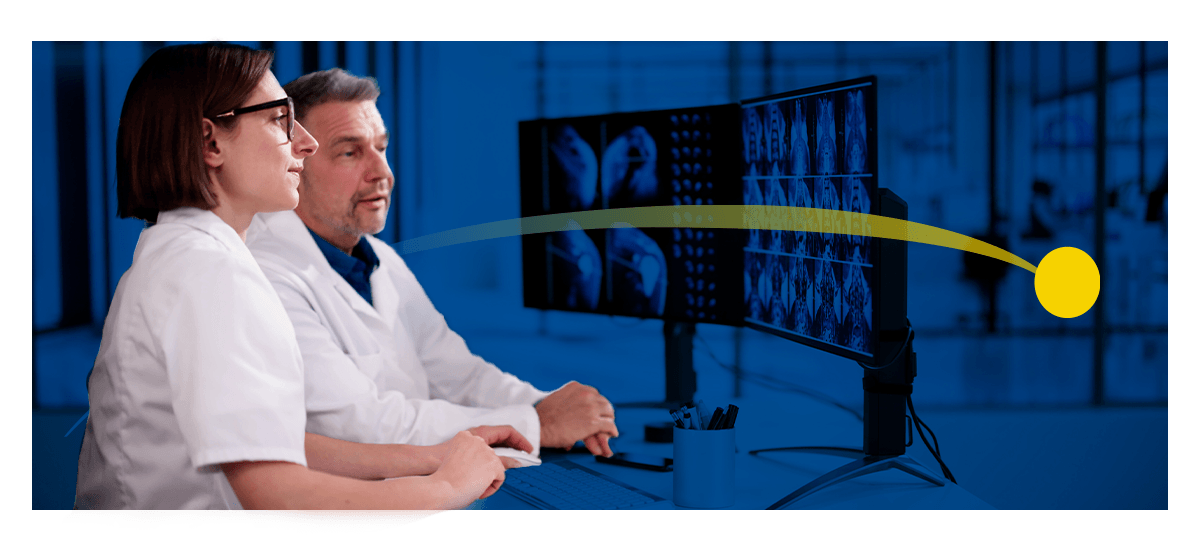How to Improve Efficiency in a Radiology Department

Radiology departments require information to flow quickly and securely to protect their resources and the patient experience. Efficiency is a key metric determining your facility's ability to perform core responsibilities such as collaborating between professionals throughout the practice, promptly reaching accurate diagnoses and offering sufficient patient care.
Common Challenges Affecting Radiology Departments Impact Productivity
The imaging process frequently involves inefficiencies, from complex examinations and improperly managed data to slow communication and bottlenecks. Beyond these technical challenges, practitioners may see increased workloads that are difficult to balance with insufficient resources, contributing to low productivity. Among these issues, poor data quality impacts team efficiency, complicates image review and extends patient wait times.
Upholding your center's commitment to providing prompt diagnostics and care requires strategies to support personnel, identify and address inefficiencies and integrate state-of-the-art tools with existing systems.
6 Key Ways to Enhance Radiology Department Efficiency
Position your practice for success with department-wide and personal efforts to optimize efficiency, preserve clinicians' focus and improve patient outcomes.
1. Embrace AI Solutions
Automating image analysis through artificial intelligence algorithms equips your practice to return results faster. With the right data, professionals can deliver accurate, timely reports. Recent AI-driven imaging solutions can detect many pathologies and abnormalities to enhance image review and support clinician assessment.
2. Leverage Teleradiology
Radiology personnel balance several tasks according to their allotted time and resources, which becomes more challenging as high workloads outgrow radiologist availability and introduce high levels of variation between case types and image data. Standardizing imaging and embracing teleradiology allows off-site specialists to receive and interpret images. By doing so, radiology departments send consistent data to available clinicians for timely review.
3. Streamline Workflows
Each practice encounters unique inefficiencies between patient scheduling, imaging and reporting. Evaluating your center's imaging process allows you to identify common reasons for delays and errors. With this information, you can select automated solutions, implement protocol changes and delegate non-clinical work to streamline workflows such as data management and administrative tasks.
4. Pursue Continuous Employee Training
Department-wide productivity relies on the personal efficiency of radiologists. After building a highly skilled staff, continuous learning maintains your practice's commitment to excellence by:
- Establishing your team's expertise through encouraging knowledge shares and collaboration
- Providing training on state-of-the-art procedures
- Making personnel familiar with advanced tools as your department implements new technology
5. Analyze Performance Metrics
Analyzing radiologist efficiency reveals opportunities for individual improvement and areas for more widespread workflow changes, training modules or department goals. Highlighting patient satisfaction, average turnaround times and report accuracy gives administrators a data-supported foundation for decision-making. With quantifiable information about your practice's performance, you can identify valuable objectives, outline metrics for measurable progress and track efficiency over time.
6. Take Advantage of Efficient Tools
Leverage cutting-edge solutions designed to streamline image sharing, storage and analysis:
- Digital imaging and communications in medicine (DICOM) image router: These routers support the movement of radiology images from the acquisition device to the workstation for review. Highly capable DICOM products quickly manage massive amounts of complex data to reduce patient wait times.
- Picture archiving and communication system (PACS): A PACS equips radiologists to store and view patient images. Advanced solutions streamline routing, offer high speeds for concurrent requests and provide reliable self-management with notification support.
Run a More Efficient Radiology Department With Candelis
Finding technology that supports seamless image reading and medical data management allows your center to make meaningful progress toward efficiency goals. At Candelis, we rapidly develop comprehensive solutions that equip radiology departments to streamline workflows, simplify complex protocols and better support patient and practitioner needs.
Candelis provides innovative and cost-effective medical imaging solutions, including ImageGrid™ PACS products and DICOM router software and server solutions. These systems allow your radiologists to maintain personal and department productivity with seamless integration, simple setup, lightning-fast operation and compatibility with complex image routing. We support our solutions with comprehensive technical assistance.
See how our technology encourages radiologist efficiency and improves patient outcomes. Complete our contact form to learn more about advanced tools that transform your practice's most critical imaging processes.
- Log in to post comments
